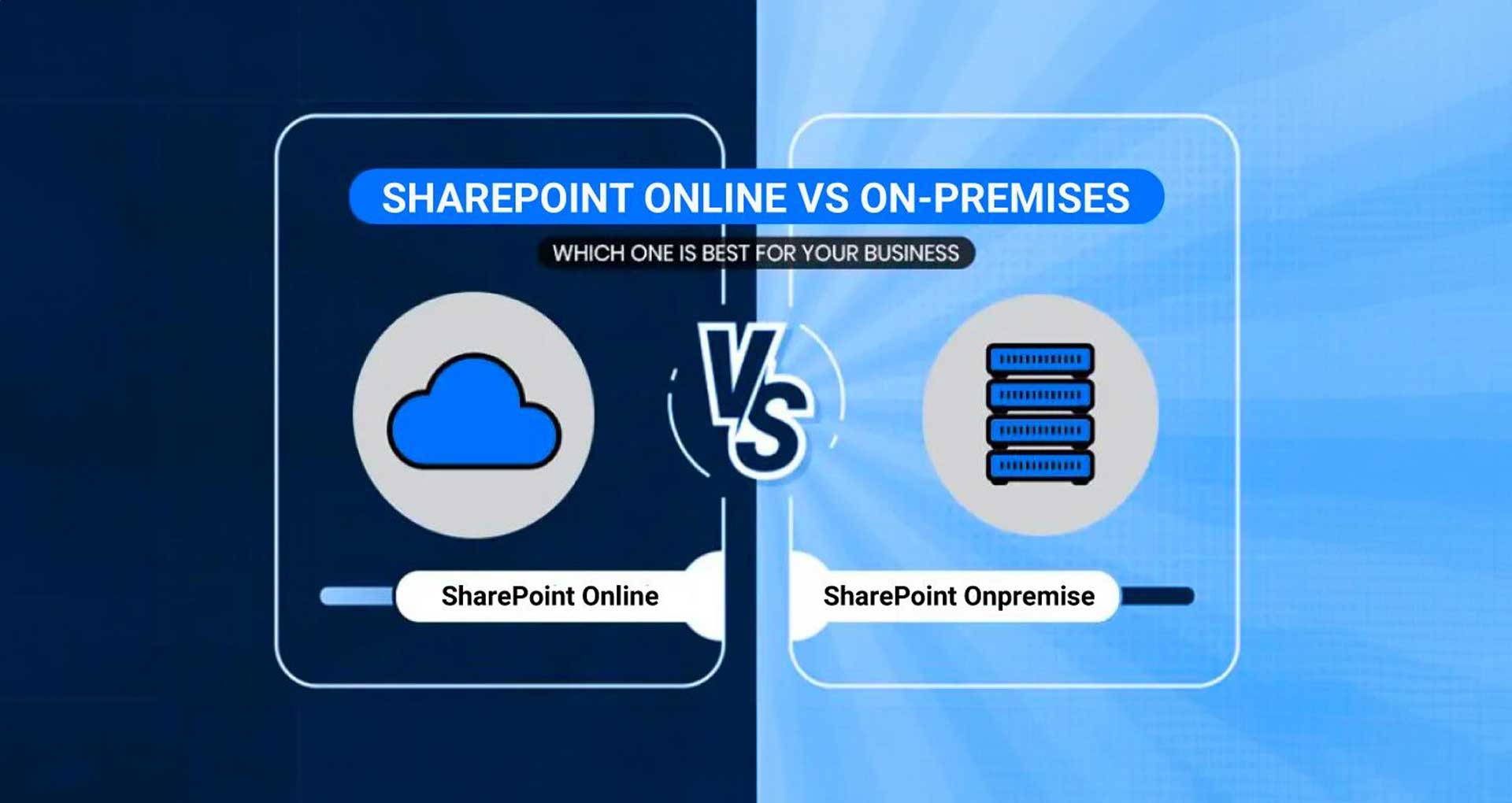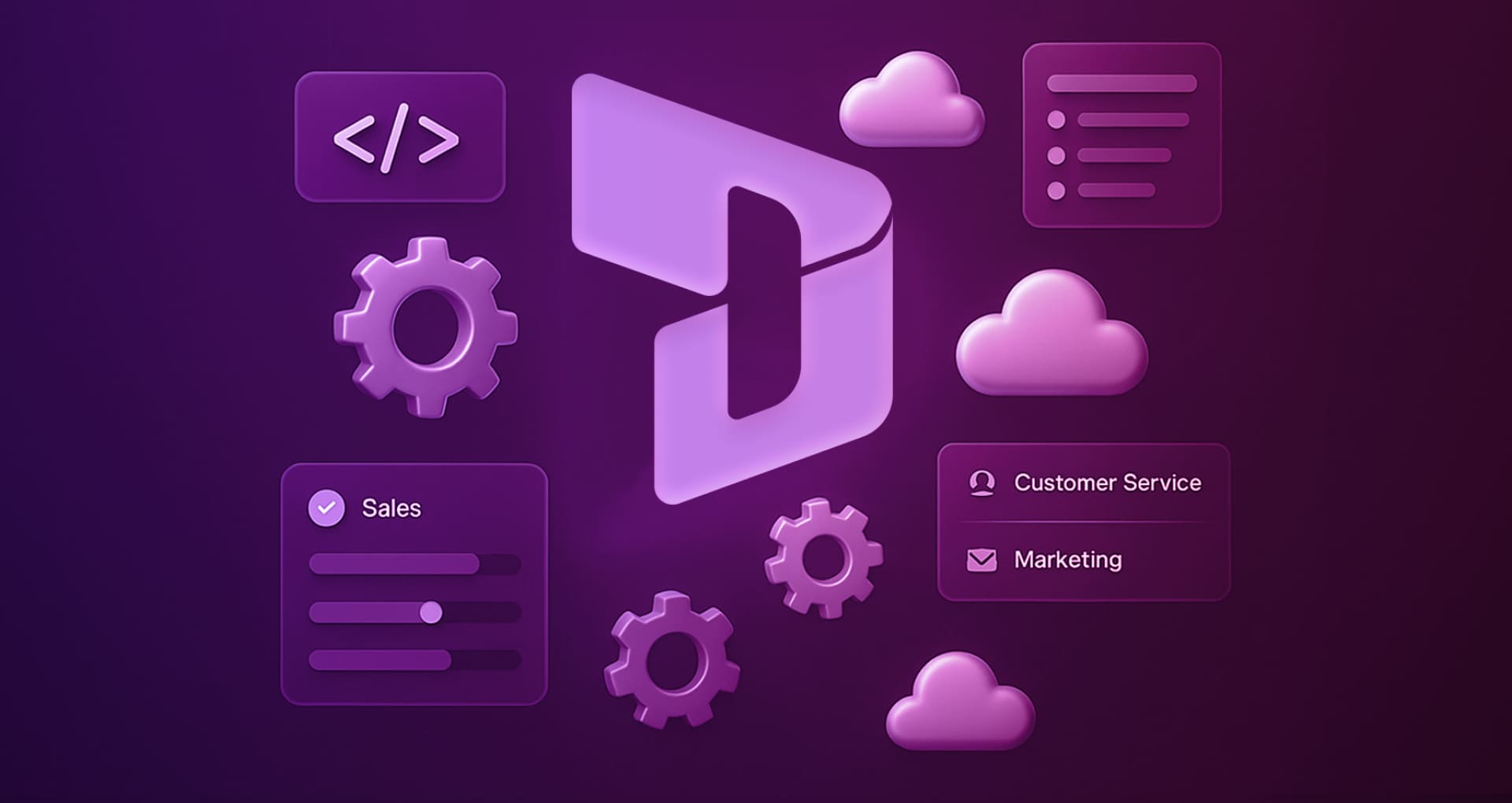In today’s competitive business landscape, organizations always seek ways to optimize and streamline workflow processes by leveraging advanced technologies. Towards this, Microsoft offers two robust solutions, SharePoint Online & SharePoint On-Premises, to meet these evolving needs.
SharePoint Online, a cloud-based application, provides a modern and scalable digital communication and collaboration platform. On the other hand, SharePoint On-Premises offers localized deployment options that grant businesses greater control and customization capabilities. However, many organizations are at a crossroads, unsure whether to migrate to SharePoint Online or stick with their on-premises setup. However, the decision-making process can often be challenging, delaying transitioning workloads to the cloud.
Through this blog get a comprehensive analysis of SharePoint Online Vs SharePoint On-Premises to enable you in making an informed choice. It would align with the operational requirements & maximize efficiency. At the same time, there are several factors to consider, capabilities to explore, and features to compare for making an informed decision.
What is the Use of Microsoft SharePoint?
Microsoft SharePoint is a powerful platform for document management, team collaboration, intranet portals, process automation, business intelligence, and customization. It enables organizations to enhance productivity, streamline operations, and improve collaboration within & beyond their boundaries.
SharePoint Online is the cloud-based version of SharePoint. It’s like having your SharePoint platform accessible through the internet. You can access it from anywhere, anytime, with an internet connection. It’s licensed per user and available as a standalone plan or part of Microsoft 365, with options catering to different needs. It integrates smoothly with other Microsoft tools like Teams, OneDrive, and Outlook. It’s a flexible and scalable solution allowing businesses to collaborate, manage documents, and streamline workflows virtually.
SharePoint On-premises is a traditional, self-hosted version of SharePoint that companies can set up on their servers in-house. Licensing follows a Server/CAL model, with options for both Standard and Enterprise CALs, delivering core and full capabilities. With on-premises, you have complete control over your SharePoint environment, including data storage and infrastructure. It’s a great option if you prefer to manage everything at your premises and have specific requirements for customization or compliance.
SharePoint Online Vs. SharePoint On-Premises Comparison
Let’s explore the main points of difference between SharePoint Online and on-premise,
Infrastructure and Maintenance
SharePoint Online:
Does not require organizations to manage their infrastructure. Microsoft handles the servers and software’s maintenance, updates, and security.SharePoint On-Premises:
With this deployment option, organizations must set up and maintain their servers, hardware & software. It would require a certain level of IT expertise with ongoing maintenance to ensure the system runs smoothly.
Scalability and Flexibility
SharePoint Online:
Offers high scalability, allowing organizations to quickly scale up or down their storage and user requirements based on their needs. It also provides flexibility in accessing content from anywhere with an internet connection.SharePoint On-Premises:
The scalability of this option largely depends on the organization’s infrastructure capability. Scaling up often requires additional hardware and resources, which can be a complex and time-consuming. Additionally, accessing content is limited to on-premises or via VPN, which may restrict remote access.
Customization and Control
SharePoint Online:
Offers a range of customization options, including site branding and custom web parts, it has some limitations when comparing SharePoint online versus on-premise. Organizations have less control over the underlying infrastructure.SharePoint On-Premises:
Provides greater control and customization capabilities. Organizations can tailor the platform extensively, including server configuration, custom development, and integration with other on-premises systems.
Cost
SharePoint Online:
Operates on a subscription-based model, with costs determined by the number of users and storage requirements. It eliminates upfront infrastructure costs but involves ongoing subscription fees.SharePoint On-Premises:
Typically requires significant upfront investment in hardware, software licenses, and infrastructure setup. However, ongoing costs may be lower once the initial investment.
Security and Compliance
SharePoint Online:
With this deployment option, Microsoft helps meet security measures, updates, and compliance requirements. It offers robust security features, including data encryption, threat detection & compliance certifications such as GDPR and ISO.SharePoint On-Premises:
Organizations have more control over security measures with this option. Though, it is essential to implement & maintain security protocols. It includes managing firewalls, data encryption, access controls & compliance measures.
Collaboration Tools
SharePoint Online:
Comprises collaboration tools like Microsoft PowerApps, Microsoft Flow, Azure functions, and more. SharePoint On-Premises:
Lacks integrated tools and applications, needing you to make separate arrangements to incorporate additional tools and applications.
Why Migrate to SharePoint Online from On-Premises?
The migration to SharePoint Online from SharePoint On-Premises allows organizations like yours to leverage cloud-based advantages. It would include cost savings, scalability, accessibility, enhanced security, and integration with Microsoft 365 services. Yet it is crucial to thoroughly analyze the specific requirements, customization needs, and potential challenges before undertaking migration to ensure a successful transition. When you move to SharePoint online, you can ensure efficient collaboration, simplified management, and optimized resource allocation for your organization.
Benefits of SharePoint Online Vs. On-Premise
Migrating to SharePoint Online brings numerous advantages over an on-premises deployment. Here’s why it’s worth considering SharePoint online over the on-prem model.
- Cost Savings: Operating on a subscription-based model, SharePoint Online eliminates the need for upfront hardware and infrastructure costs associated with On-Premises deployments. Companies can benefit from predictable monthly or annual subscription fees, reducing capital expenditure while shifting operational expenses.
- Scalability and Flexibility: SharePoint Online allows organizations to adjust storage capacity and user licenses as required quickly. It offers the flexibility to scale up or down per evolving business requirements while avoiding investing in additional hardware or infrastructure.
- Automatic Updates: Being a cloud-based software, SharePoint Online manages the updates, patches, and security enhancements while ensuring organizations benefit from the latest version of SharePoint. It eliminates the need for manual updates & reduces the burden on IT teams to keep the system up-to-date and secure.
- Accessibility and Remote Collaboration: With an internet connection, SharePoint Online enables easy access to content and collaboration tools from anywhere. It holds for organizations with distributed teams, remote workers, or those who require external collaboration. And users can access SharePoint Online using a web browser or mobile app, promoting seamless collaboration and information sharing.
- Enhanced Security and Compliance: Microsoft invests heavily in data security measures for SharePoint Online. It provides robust security features, including data encryption, threat detection, and compliance certifications such as GDPR and ISO.
- Integration with Microsoft 365 Services: SharePoint Online integrates with other Microsoft 365 services such as Microsoft Teams, OneDrive, and Power Platform Suite. This integration enhances productivity, streamlines workflows, and allows for a unified collaboration experience across various tools.
- Focus on Core Business Functions: With SharePoint Online, organizations can offload the management and maintenance of infrastructure to Microsoft. This can free up IT resources to focus on core business functions, strategic initiatives, and driving innovation. It would be better than spending time on server maintenance and troubleshooting.
- Continuity and Disaster Recovery: SharePoint Online helps ensure data protection and business continuity. It is made possible with Microsoft’s data centers’ built-in backup and disaster recovery capabilities. It provides redundancy & reliable backups while minimizing the risk of data loss and providing peace of mind for organizations.
Ready to make a move to SharePoint online? It’s an intelligent choice, but take the time to assess your organization’s needs and requirements, conduct thorough testing, and reach out to a trusted technology partner like Rishabh Software for guidance. With our experience, we can help you navigate the migration process and ensure a successful transition to SharePoint Online.
Additionally, it’s worth exploring the concept of SharePoint Hybrid and understanding how deploying SharePoint in a hybrid environment can be beneficial.
What is SharePoint Hybrid & Why Deploy SharePoint in a Hybrid Environment
SharePoint Hybrid is a deployment model combining both SharePoint Online (cloud-based) and SharePoint On-Premises (locally hosted) environments. It allows companies to leverage the benefits of both deployment options while creating a seamless integration.
Listed below are some of the reasons why deploying SharePoint in a hybrid environment can be beneficial:
- Flexibility and Customization: It allows organizations to choose where their SharePoint resources are hosted. It will enable them to keep sensitive or critical data on-premises while leveraging the scalability and flexibility of the cloud for other & related workloads. And hybrid approach enables companies to customize their SharePoint environment while meeting specific business requirements.
- Compliance and Data Sovereignty: In our experience, a few organizations have stringent regulatory or compliance requirements. They would mandate data to be stored on-premises. But with a hybrid deployment, modern-day organizations can ensure compliance by keeping sensitive data within their local infrastructure. It is still using the cloud for non-sensitive data and further collaboration.
- Seamless Collaboration and User Experience: Enables organizations to access & share documents and calendar tasks across the cloud and on-premises environments. Though it is regardless of resources location & where the data is stored. The hybrid approach allows users to experience a consistent and unified interface while improving productivity and collaboration within the organization.
- Extended Functionality: By utilizing SharePoint in a hybrid environment, organizations can use additional features and capabilities. Integrating cloud-based services like Microsoft Power Automate, Power Apps, and Microsoft 365 Groups into their on-premises deployment. It would help enhance productivity and expand the functionality of their SharePoint environment.
- Disaster Recovery and Business Continuity: With a hybrid deployment, organizations can leverage robust disaster recovery & business continuity options. It would include a cloud for backup, replication, and redundancy, ensuring data availability & minimizing the risk of data loss or system downtime.
- Migration Flexibility: Interestingly, the hybrid approach offers organizations to experience utilizing the cloud while having an existing on-premises SharePoint deployment. They can eventually move to the cloud with a phased migration strategy. And it would enable transferring specific workloads or sites to the cloud at their own pace while minimizing disruption and maximizing user adoption.
Making the Right Choice: SharePoint Online vs. On-Premise
By understanding your needs and considering factors like compliance, customization, storage, and control, you can decide whether SharePoint on-premise vs. SharePoint online is the best choice for your organization’s unique requirements.
When to Choose SharePoint Online
SharePoint Online helps save costs & reduces complexity. With this option, organizations can avoid spending time and money creating the necessary infrastructure.
- Team Collaboration to leverage features like team sites, document libraries, lists, and real-time co-authoring, enabling seamless collaboration and communication.
- Document Management by leveraging features such as version control, metadata tagging, search capabilities, and permissions management, making storing, finding, and collaborating on documents more accessible.
- Intranet and Company-wide Communication to disseminate important information, share updates, and engage employees across the organization.
- Business Process Automation to automate business processes and streamline repetitive tasks. By leveraging Power Automate with SharePoint, organizations can create custom workflows to automate approvals, document routing, and notifications, improving efficiency and reducing manual effort.
- Knowledge Sharing and Content Management to use features like wikis, blogs, discussion boards, and content categorization, facilitating knowledge exchange and content organization.
- Security and compliance to protect your organization’s sensitive data with advanced access controls, encryption options, data loss prevention (DLP) policies, and compliance tools to ensure data security and regulatory compliance.
- Remote Work and Mobile Access to documents and collaboration tools from anywhere, using any device. This flexibility is particularly beneficial for organizations with distributed teams or remote employees.
When to Choose SharePoint On-Premises
SharePoint On-Premises is the perfect fit if you already have a dedicated infrastructure. Listed are some scenarios where selecting this model might be appropriate:
- Data Privacy and Security for organizations with strict regulatory or compliance requirements to keep the data within their infrastructure. It enables the implementation of specific security measures tailored to the organization’s needs and ensures compliance with industry standards.
- Customization and integration for complex business processes or extensive customizations require deep integration with other systems or legacy applications. Companies get complete control over the server environment and customize SharePoint extensively to suit their unique requirements.
- Bandwidth and Network Connectivity to enable users to access and collaborate on documents & content locally. It is without the dependence on internet connectivity. It is essential for organizations in remote or low-bandwidth areas where reliable internet access might pose a challenge.
- Complete Administrative Control to control the infrastructure, including hardware, server configurations, and maintenance schedules. It enables IT teams to control, manage and optimize the SharePoint environment as per the specific organizational needs to ensure better performance & resource utilization.
Tip: SharePoint On-Premise versions have end-of-life, but SharePoint Online does not. Microsoft’s End-of-Life (EOL) support for SharePoint On-Premises version as listed below;Version
SharePoint 2013
SharePoint 2016
SharePoint 2019
EOL
Apr 11, 2023
Jul 14, 2026
Jul 14, 2026Although reaching EOL does not mean any immediate disappearance of documents and data, it does present significant risks to your business operations and continuity. Do enquire how Rishabh Software can help you manage your existing technology ecosystem or help you migrate to the cloud if needed.
Why Choose Rishabh Software For SharePoint Development?
Deciding between SharePoint cloud vs on-premise can be overwhelming for businesses unfamiliar with each option’s features. Your choice ultimately depends on your specific needs, requirements, and business objectives. Both deployment models provide versatile features, and a detailed comparison can guide you in selecting the right solution for your organization.
Once you have chosen your preferred SharePoint platform, it is advisable to engage a trustworthy SharePoint development partner who can ensure a smooth migration process. With two decades of experience and as a Microsoft Gold Certified Partner, we specialize in delivering professional SharePoint Development Services. It would include the deployment & implementation of Microsoft SharePoint applications, Azure, and Microsoft Teams.
Listed below are the services we offer;
- SharePoint Development
- SharePoint Migration
- SharePoint Integration
- SharePoint Consulting
- SharePoint BI & Reporting
Our team has access to all major platforms like SharePoint Online, with related SharePoint libraries, Power Platform Suite, Microsoft 365, and more, making us the top choice for companies of all sizes.











 30 Min
30 Min


